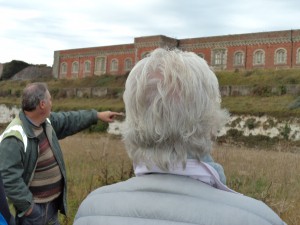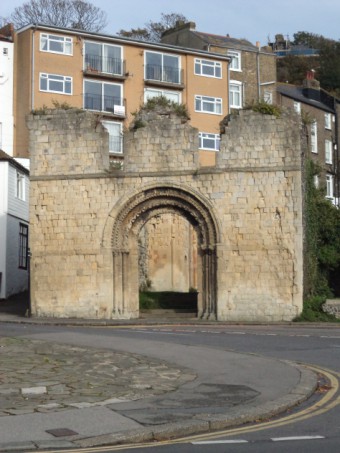Before I get to what I have been doing this week, I thought I would mention that Dr Martin Watts has been continuing to work on Richborough’s role in the Great War and has been in contact with a potential speaker for a one-day conference that he is planning in 2016. To that end there will be a meeting with his colleagues in Christ Church this coming Tuesday, so hopefully I will have more to report on this venture next week. Secondly, as you may remember Dr John Bulaitis gave the Nightingale Memorial Lecture at the beginning of this month and today he and Professor Jackie Eales visited the Agricultural Museum, Brook, the other partner in the lecture at Christ Church and the founder of the lecture series. I shall be interested to hear about their visit and their impressions of the Museum’s medieval great barn, its collection of agricultural machinery and the early round-shaped oast house.
My focus this week will be on Dover because I visited the town on Wednesday to act as Keith Parfitt’s back marker for his Canterbury Festival walk around the fortifications on the Western Heights. As a medievalist, much of what Keith showed the very appreciative group was far too late in that we looked at the massive 19th-century earthworks, ramparts and buildings. However it was still a fascinating morning because even though I knew of their existence and had seen photos of them, you really cannot appreciate the scale of the place until you stand at the bottom of the moat at the Drop Redoubt and look up at the massive brick walls and the corner gun towers. As Keith pointed out, you can see how the different phases of building took place by looking for the different coloured bricks, the points of discontinuity between the brickwork and the different sizes of the gun points as the technology dependent on small arms was replaced by machine guns. So the group soon got the hang of working out which was 1800s work and which from the 1860s. Similarly Keith demonstrated the differences between 19th-century work and that from the two World Wars, as well as showing how you could see in the magazine store without blowing yourself up, and everything else around you. And on a lighter note, he remarked that a tramp had in the past given his official address as The Old Magazine, St Martin’s Battery; that is an underground hole at the back of a gun emplacement.
All of this was extremely interesting but I must admit the real gem from my perspective was the Citadel, recently the Immigrant Removal Centre, but the most fantastic 19th-century building as you can see from the photo below.

As you may have guessed if you know Dover Castle and the Historic Dockland at Chatham this was the officers’ quarters. The idea being, amongst others, that if the other defences had been taken by the French and the town lost to the invaders, the officers would retreat to their ‘citadel’ and defend it to the last man. However, like so much of the defensive work thrown up around the English coast, its defences were never tested, which is probably a good job because it would have been such a pity to damage this wonderful mock-Gothic brickwork. Keith thinks the bricks came from the north Kent brick fields, especially those of Gillingham, and whoever had the contract must have become a multimillionaire. It wasn’t just the officers who lived there, though, because for a while at least there was a pet tiger. Presumably it came back from India with one of the regiments and there are photos of it, Keith said, sitting on the front steps. Nevertheless its days were numbered because it bit someone, which was the commander’s only proviso about its living there, and it was therefore shot. Whether its skin was preserved there was not explored but seems likely considering the ideas of the time.
The medieval period was not totally missing from Keith’s tour and we looked at what is reputed to be the foundations of a Knights Templar church. It is tiny so I must admit I’m not convinced, especially as there is really nothing to prove this association. Certainly the Templars were at Temple Ewell, when the order was disbanded in disgrace the preceptory was taken over by the Hospitallers, but whether they started on the Western Heights is a moot point. Yet someone built what was probably a chapel, although Keith thinks it might also have acted as a landmark for mariners coming along the Channel, something that happened elsewhere along the coast. There was a later medieval chapel on the foreshore dedicated to Our Lady and it is possible there was some relationship between the two.
However that’s enough speculation so I’ll now turn to the other part of the day that was special. After his guided walk Keith very generously showed me around Canterbury Archaeological Trust’s excavation in Dover. The site is very close to Keith’s earlier successful Townwall Street dig which found plenty of evidence for Dover’s fishermen’s settlement and this new site has many parallels. Again vast amounts of fish bones and fish hooks have been found, as well as large amounts of pottery, some Kentish ware but also from overseas. Perhaps one of the most intriguing discoveries so far is the number of times the road running across the site was resurfaced in the Middle Ages, and the depth of material that was packed in on each occasion. Keith’s theory at the moment is that the underlying ground was just so low and swampy that the inhabitants had a constant battle to keep the road serviceable. There were medieval houses abutting the road which have also revealed some interesting features such as the repeated flooring of these dwellings using chalk and debris from the central hearth. These places also seem to have had courtyards, perhaps where the fish were gutted, nets were mended and other such occupations were undertaken, all of which leave very few traces. The three main sectors of this excavation are coming to an end, but an adjacent area is being cleared ready for the archaeologists. Yet it is still a great pity that the whole site is not being excavated thoroughly.
I shall hope to bring you more news about this excavation at a later date, especially if I get the chance to explore Dover’s medieval records again because it is over a decade since I last looked at the civic treasurers’ accounts and the charters of the various religious houses in the town. Also last time I was looking for other things, particularly the fishermen and the town defences, so it would be great to extend this to the townspeople more generally in St James’ parish. Talking of this parish reminds me that Keith pointed out some exceedingly worrying cracks in the stonework of the west wall of the church. Even though it is a ruin, having been damaged on several occasions, it is in grave danger of falling down according to structural engineers who have looked at it, and even my uneducated eyes could see three large cracks running up vertically to almost the full height of what remains. Indeed you can see one of the cracks in the photo at the top of this post. Keith and Paul Bennett, the Director of CAT, are trying to get something done about it because Keith fears another wet/hard winter may see it fall.
A rather depressing note, consequently I thought I would finish instead by mentioning Dover’s own medieval ‘saints’. For, even though St Martin appears on the medieval seal used by the town, he was from Tours whereas Dover had a saintly bishop and a saintly monk. Bishop Richard of Chichester was on a recruiting campaign on behalf of the forthcoming crusade when he consecrated the little chapel of St Edmund in 1253. The poor man was seriously ill at the time and died a few days later at St Mary’s Hospital. His body was taken back to Chichester but Dover keep his entrails and these were buried ceremoniously in the newly consecrated chapel. Soon miracles occurred and in 1261 he joined the list of saints. The second shrine in the town was dedicated to Thomas de la Hale. The elderly monk had remained in Dover Priory when it was attacked by French raiders in 1295, his fellow monks having fled. When he refused to tell the French where the priory’s treasure was kept they murdered him and ransacked the buildings. Coming back after the raiders had departed, the monks buried him with great ceremony and the following year the bishop of Winchester gave a 40-day indulgence to any who prayed for the soul of the dead monk. Moreover Thomas was credited as a miracle-working saint, including restoring a withered hand, making four blind men see and restoring the wits of a madman. I must admit I quite like the idea of the little wax-shaped boats that were offered by sailors at the monk’s shrine, a change from the wax limbs which may still have adorned St Thomas of Canterbury’s shrine, although that shrine did have Dover’s gift of the great candle. Whether this link between Dover and Canterbury will be mentioned by either Professor Nicholas Vincent or Dr Diana Webb at the Medieval Canterbury Weekend next April we shall just have to wait to find out.
 Centre for Kent History and Heritage
Centre for Kent History and Heritage Matthew Crockatt
Matthew Crockatt 1208
1208


